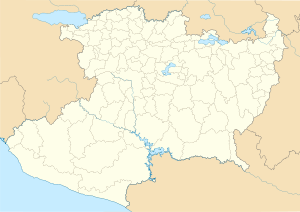Paricutín
| Paricutín | ||
|---|---|---|
|
The Paricutín volcano |
||
| height | 2800 m | |
| location | Michoacan , Mexico | |
| Dominance | 5.4 km → Cerro Tancítaro | |
| Notch height | 215 m | |
| Coordinates | 19 ° 29 '37 " N , 102 ° 15' 4" W | |
|
|
||
| Type | Cinder cone | |
| Last eruption | 1952 | |
The Paricutín volcano has a height of 2800 meters (whereby it towers above its surroundings by 424 meters) and is located in the Mexican state of Michoacán . The city of Uruapan is about 20 kilometers southeast of the volcano.
Emergence
The volcano was formed on February 20, 1943 . A new vent opened in the 40,000 km² Michoacán-Guanajuato volcanic field , which comprises more than 900 monogenetic cinder cones (volcanoes that erupt only once). On average, around two eruptions per 1000 years can be expected in this area.
There are many contradicting stories about his birth. The best known is that of the farmer Dionisio Pulido and his wife Paula, who experienced the birth of the volcano with a dull "plop" on their maize field. A day later the volcano was already ten meters high and on February 22nd it was 50 meters.
Active phase
Just one year after its creation, the mountain, which was soon named after the nearby village of Paricutín, reached a height of 336 meters.
Over the years the villages of San Juan Parangaricutiro and Paricutín have been covered by ash rains and lava flows . Since the destruction was slow, the places could be evacuated in time and there were no casualties among the population. Remains of a village church rise from a field of solidified lava near the volcano.
In 1952 the volcano stopped its activities. He had grown to 424 meters. Due to the monogenetic nature of the volcanic field, no further eruptions of the Paricutín are to be expected.
Because of its origin, the Paricutín is often referred to as one of the natural wonders of the world .
The professional photographer Hugo Brehme of German descent was able to photograph the creation. His black and white image shows a lava flow pouring to the right. The column of smoke rises vertically and is symmetrical in itself.
reception
In the novel Stiller by Max Frisch , the protagonist Mr. White claims to have worked at that very volcano birth on a tobacco plantation. He tries u. a. so to convince his lawyer that he was not the Stiller he was looking for.
Egon Erwin Kisch dedicates a chapter in his work Discoveries in Mexico (1945) to the eruption of the volcano and also mentions the genesis of Dionisio Pulido .
The “birth” of the Paricutín plays a central role in the novel Befers van Liefde by Albert Helman (Uitg. Nijgh & Van Ditmar, Amsterdam 1988).
In 1970 the crater rim of the volcano was the location for a land art project by the British-American artist Peter Hutchinson .
literature
- JF Luhr and T. Simkin: Parícutin: The volcano born in a Mexican cornfield . Geoscience Press, Phoenix, 1993.
- Egon Erwin Kisch : Discoveries in Mexico . Droemer Knaur, 1992, ISBN 3426010887
Web links
Photos and videos
- Volcano Paricutin on YouTube (documentation, English, 4 min)
Scientific contributions
- Michoacán Vulkanfeld in the Global Volcanism Program of the Smithsonian Institution (English)
- V. Camp: Paricutin , How Volcanoes Work, Dept. of Geological Sciences, San Diego State University (English)
Individual evidence
- ↑ Instituto Nacional de Estadística y Geografía: Elevaciones principales - Michoacán de Ocampo. (No longer available online.) 2005, archived from the original on September 28, 2011 ; Retrieved March 2, 2010 (Spanish). Info: The archive link was inserted automatically and has not yet been checked. Please check the original and archive link according to the instructions and then remove this notice.
- ^ In: Walter Schmiedehaus, Mexico. The Aztec Empire on the threshold of the future. Goldmann, Munich 1960, p. 18 (panel on art paper)





